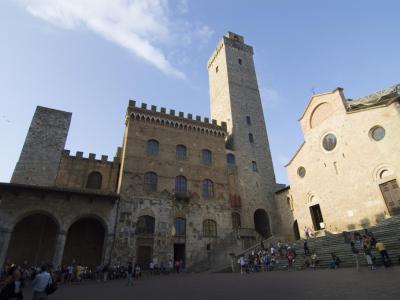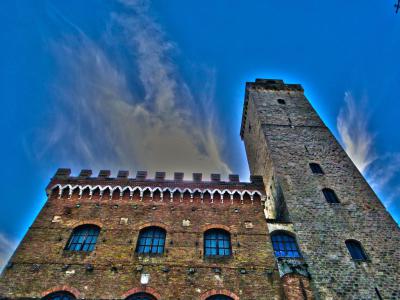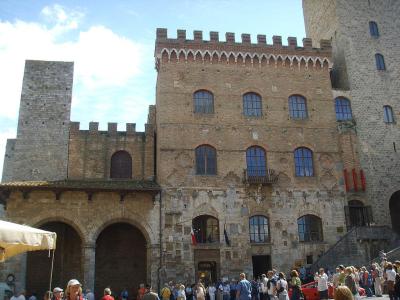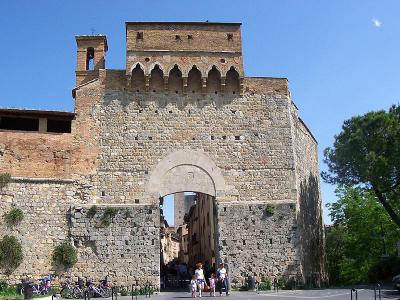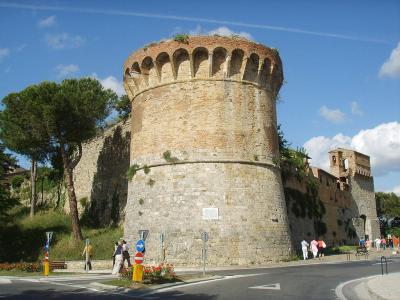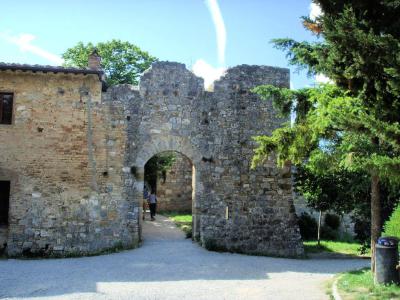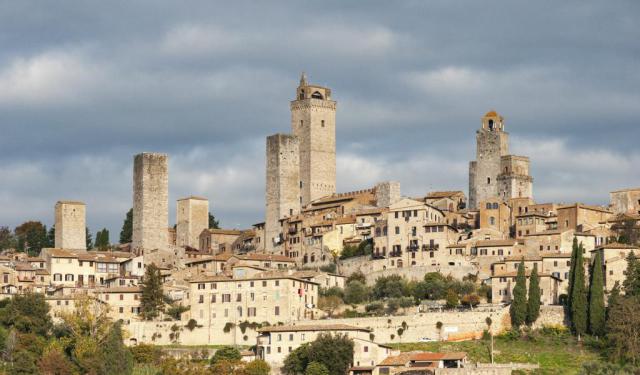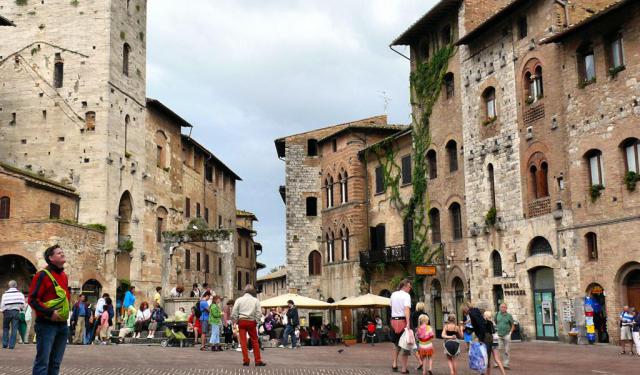
San Gimignano Introduction Walking Tour (Self Guided), San Gimignano
Visitors are universally spellbound when they discover San Gimignano, one of the many jewels in the crown of Italy’s Tuscany. The reason for this lies in the well-preserved feudal atmosphere and appearance from the Middle Ages with its architectural integrity and original intact urban layout.
The history of the town dates back to the Etruscan period. However, it was during the Middle Ages that San Gimignano flourished, through trade, and became prosperous along the Via Francigena, an important pilgrimage route. The town grew in wealth and power, with rival factions vying for its control. As a symbol of social status, noble families constructed tall tower houses. At its peak, San Gimignano had over 70 towers, but today only 14 remain standing as its most distinctive feature.
Indeed, rising like a medieval mirage towards the heavens, a shimmering vision of these imposing towers of stone produces quite an impression. Climbing at least one of them, such as the Big Tower (Torre Grossa) for instance, is a must-do experience for the panoramic views of the surrounding countryside that it provides from the top floor.
The name "San Gimignano" is derived from the name of the town's patron saint, Saint Geminianus, a 4th-century bishop of Modena.
San Gimignano's well-preserved medieval center is a UNESCO World Heritage site. Exploring it on foot allows visitors to discover hidden corners and architectural gems.
The triangular Cistern Square (Piazza della Cisterna) is the heart of San Gimignano. This square is named after the ancient well (cisterna) located in its center. The square is lined with medieval buildings and is an excellent spot for people-watching while enjoying gelato or a coffee.
Cathedral Square (Piazza del Duomo) is home to the Collegiate Church of Santa Maria Assunta (Collegiata di Santa Maria Assunta), the main temple of San Gimignano, adorned with frescoes by the Renaissance painters such as Benozzo Gozzoli. It also houses the impressive Communal Palace (Palazzo Comunale), a striking medieval building that accommodates the town hall.
History enthusiasts with a taste for medieval Italy will find the SanGimignano1300 Museum and the Museum of Torture and Death Penalty particularly interesting.
There are many reasons to include San Gimignano in your itinerary. This pretty hilltop town is a living testament to the golden age of Tuscany. Wandering its quaint winding streets, you can feel the spirit of the Middle Ages linger in every corner and alleyway. If you wish to breathe the air perfumed with the whispers of a bygone era, this self-guided walk is a good opportunity for that.
The history of the town dates back to the Etruscan period. However, it was during the Middle Ages that San Gimignano flourished, through trade, and became prosperous along the Via Francigena, an important pilgrimage route. The town grew in wealth and power, with rival factions vying for its control. As a symbol of social status, noble families constructed tall tower houses. At its peak, San Gimignano had over 70 towers, but today only 14 remain standing as its most distinctive feature.
Indeed, rising like a medieval mirage towards the heavens, a shimmering vision of these imposing towers of stone produces quite an impression. Climbing at least one of them, such as the Big Tower (Torre Grossa) for instance, is a must-do experience for the panoramic views of the surrounding countryside that it provides from the top floor.
The name "San Gimignano" is derived from the name of the town's patron saint, Saint Geminianus, a 4th-century bishop of Modena.
San Gimignano's well-preserved medieval center is a UNESCO World Heritage site. Exploring it on foot allows visitors to discover hidden corners and architectural gems.
The triangular Cistern Square (Piazza della Cisterna) is the heart of San Gimignano. This square is named after the ancient well (cisterna) located in its center. The square is lined with medieval buildings and is an excellent spot for people-watching while enjoying gelato or a coffee.
Cathedral Square (Piazza del Duomo) is home to the Collegiate Church of Santa Maria Assunta (Collegiata di Santa Maria Assunta), the main temple of San Gimignano, adorned with frescoes by the Renaissance painters such as Benozzo Gozzoli. It also houses the impressive Communal Palace (Palazzo Comunale), a striking medieval building that accommodates the town hall.
History enthusiasts with a taste for medieval Italy will find the SanGimignano1300 Museum and the Museum of Torture and Death Penalty particularly interesting.
There are many reasons to include San Gimignano in your itinerary. This pretty hilltop town is a living testament to the golden age of Tuscany. Wandering its quaint winding streets, you can feel the spirit of the Middle Ages linger in every corner and alleyway. If you wish to breathe the air perfumed with the whispers of a bygone era, this self-guided walk is a good opportunity for that.
How it works: Download the app "GPSmyCity: Walks in 1K+ Cities" from Apple App Store or Google Play Store to your mobile phone or tablet. The app turns your mobile device into a personal tour guide and its built-in GPS navigation functions guide you from one tour stop to next. The app works offline, so no data plan is needed when traveling abroad.
San Gimignano Introduction Walking Tour Map
Guide Name: San Gimignano Introduction Walking Tour
Guide Location: Italy » San Gimignano (See other walking tours in San Gimignano)
Guide Type: Self-guided Walking Tour (Sightseeing)
# of Attractions: 12
Tour Duration: 1 Hour(s)
Travel Distance: 1.0 Km or 0.6 Miles
Author: nataly
Sight(s) Featured in This Guide:
Guide Location: Italy » San Gimignano (See other walking tours in San Gimignano)
Guide Type: Self-guided Walking Tour (Sightseeing)
# of Attractions: 12
Tour Duration: 1 Hour(s)
Travel Distance: 1.0 Km or 0.6 Miles
Author: nataly
Sight(s) Featured in This Guide:
- Piazza del Duomo (Cathedral Square)
- Collegiata di Santa Maria Assunta (Collegiate Church of Saint Mary of the Assumption)
- Torre Grossa (Big Tower)
- Palazzo Comunale (Town Hall)
- Piazza della Cisterna (Cistern Square)
- SanGimignano1300 Museum
- Via San Giovanni (San Giovanni Street)
- Museum of Torture and the Death Penalty
- Porta San Giovanni (Saint John's Gate)
- Mura di San Gimignano (Walls of San Gimignano)
- Rocca di Montestaffoli (Rock of Montestaffoli)
- Via San Matteo (San Matteo Street)
1) Piazza del Duomo (Cathedral Square) (must see)
In the center of San Gimignano, at the intersection of the north-south Francigena Street and the east-west Pisa-Siena Road, is Cathedral Square (Piazza del Duomo). Travelers entering this slanted, irregular, brick-paved space suddenly find themselves in 11th-century Italy. Imposing medieval towers and palaces crowd the edges, all unchanged since the medieval time.
The 11th-century Collegiate Church of St. Mary of the Assumption (Collegiata di Santa Maria Assunta), or Cathedral (Duomo) dominates the square atop a flight of steps. On the north side of the square are Salvucci Twin Towers (Torri Gemelle Dei Salvucci). They are the twin towers of the noble Salvucci family.
Opposite the Cathedral is the Old Mayor's Palace (Palazzo Vecchio del Podesta). In 1500, the Mayor moved to the New Palace (Palazzo Nuovo), and the Old Palace became a theatre. Its facade has an arch topped with "Guelf" battlements. Inside is a painting of Madonna with Child by Mannerist painter Giovanni Antonio Bazzi, also known as "Il Sodoma."
Mangy Tower (Torre Rognosa) is 168 feet high, and has 17 floors. It is second in height only to the better-known of San Gimignano's towers, the 177-foot-high Big Tower of the Town Hall.
The 11th-century Collegiate Church of St. Mary of the Assumption (Collegiata di Santa Maria Assunta), or Cathedral (Duomo) dominates the square atop a flight of steps. On the north side of the square are Salvucci Twin Towers (Torri Gemelle Dei Salvucci). They are the twin towers of the noble Salvucci family.
Opposite the Cathedral is the Old Mayor's Palace (Palazzo Vecchio del Podesta). In 1500, the Mayor moved to the New Palace (Palazzo Nuovo), and the Old Palace became a theatre. Its facade has an arch topped with "Guelf" battlements. Inside is a painting of Madonna with Child by Mannerist painter Giovanni Antonio Bazzi, also known as "Il Sodoma."
Mangy Tower (Torre Rognosa) is 168 feet high, and has 17 floors. It is second in height only to the better-known of San Gimignano's towers, the 177-foot-high Big Tower of the Town Hall.
2) Collegiata di Santa Maria Assunta (Collegiate Church of Saint Mary of the Assumption) (must see)
The Collegiate Church of Saint Mary of the Assumption (Collegiata di Santa Maria Assunta) is also called the Cathedral (Il Duomo). It is located in the Cathedral Square (Piazza del Duomo), on the site of an earlier church, built in the 10th century. The present edifice was consecrated in 1148 and made collegiate in 1471. The Cathedral has the relics of the town's patron Saint, Geminianus, Bishop of Modena.
The great poet and "Father" of Italian literature, Dante Alighieri, may have visited the Cathedral as Ambassador of the Guelph League of Tuscany to San Gimignano. It is certain that the Christian preacher and reformer Girolamo Savonarola preached there in 1497.
The church facade faces east, its chancel faces west. The architectural style is definitely Romanesque, but two chapels are Renaissance. The unadorned facade is reached from the square by a wide flight of steps. There are doors with lintels and recessed arches to the side aisles, but nothing in the center.
There is a large central ocular window and two smaller windows over the aisle portals. The architect of credit is Matteo di Brunisend. The facade was raised in 1340. The square bell tower is on the north side. On the south side is the loggia of the baptistery. It has an arcaded cloister with columns and a groin vault.
Inside, the church is laid out in a Latin cross plan with the center nave flanked by the two aisles. The aisles are set off by arcades of Romanesque arches on Corinthian columns. The rectangular chancel has a single arched window. The roofs are four-part Gothic style vaults. The clerestory is dimly lighted by small windows.
The voussoirs of the arcades of the Romanesque interior are alternately striped in black and white marble. The vaults are painted with gold stars in skies of lapis lazuli. The geometric vault ribbing is picked out in red, white and gold.
The church is famous for its well-preserved frescoes. The paintings are mostly from the 14th century. They show scenes from the Old and New Testaments, the Last Judgement, and the Life of Christ.
The great poet and "Father" of Italian literature, Dante Alighieri, may have visited the Cathedral as Ambassador of the Guelph League of Tuscany to San Gimignano. It is certain that the Christian preacher and reformer Girolamo Savonarola preached there in 1497.
The church facade faces east, its chancel faces west. The architectural style is definitely Romanesque, but two chapels are Renaissance. The unadorned facade is reached from the square by a wide flight of steps. There are doors with lintels and recessed arches to the side aisles, but nothing in the center.
There is a large central ocular window and two smaller windows over the aisle portals. The architect of credit is Matteo di Brunisend. The facade was raised in 1340. The square bell tower is on the north side. On the south side is the loggia of the baptistery. It has an arcaded cloister with columns and a groin vault.
Inside, the church is laid out in a Latin cross plan with the center nave flanked by the two aisles. The aisles are set off by arcades of Romanesque arches on Corinthian columns. The rectangular chancel has a single arched window. The roofs are four-part Gothic style vaults. The clerestory is dimly lighted by small windows.
The voussoirs of the arcades of the Romanesque interior are alternately striped in black and white marble. The vaults are painted with gold stars in skies of lapis lazuli. The geometric vault ribbing is picked out in red, white and gold.
The church is famous for its well-preserved frescoes. The paintings are mostly from the 14th century. They show scenes from the Old and New Testaments, the Last Judgement, and the Life of Christ.
3) Torre Grossa (Big Tower) (must see)
And the prize for the tallest tower goes to...Big Tower (Torre Grossa)! Built in 1311 and measuring 177 feet in height, it is one of Tuscany's most famous medieval towers. It is the only one of two of the existing 14 towers of the town that is open to the public. The walls of the tower enclose a belfry with a walkway to the top and the best views in town.
Construction began on August 21, 1300, four months after a visit to the city by the great Italian poet Dante Alighieri. The tower is square, with walls seven feet thick made of stone bricks. The towers of the town were built originally as defensive lookout towers. Attacks from other towns and even nearby families were not unusual.
Noble families came to value the towers as status symbols. Having the biggest tower in town was a great way to show up one's neighbors. Big Tower was the envy of the city. The adjoining Town Hall (Palazzo Comunale) is also open to the public. There are 218 steps and a ten-foot ladder to the top of the tower and the best views in Tuscany.
The tower competition among the families building their tower houses resulted in taller and taller residences. By the end of the medieval period there were towers measuring as high as 230 feet above the street. Finally the council ruled no tower could be taller than that of the Town Hall, which happened to be Big Tower.
The city with its towers flourished until 1349. The Black Death had arrived in Europe. San Gimignano lost half its population. The city was submitted to the rule of Florence. The era of higher and higher tower building was over. San Gimignano kept its Medieval appearance until the age of tourism. In a strange way, the plague was a mixed blessing.
Construction began on August 21, 1300, four months after a visit to the city by the great Italian poet Dante Alighieri. The tower is square, with walls seven feet thick made of stone bricks. The towers of the town were built originally as defensive lookout towers. Attacks from other towns and even nearby families were not unusual.
Noble families came to value the towers as status symbols. Having the biggest tower in town was a great way to show up one's neighbors. Big Tower was the envy of the city. The adjoining Town Hall (Palazzo Comunale) is also open to the public. There are 218 steps and a ten-foot ladder to the top of the tower and the best views in Tuscany.
The tower competition among the families building their tower houses resulted in taller and taller residences. By the end of the medieval period there were towers measuring as high as 230 feet above the street. Finally the council ruled no tower could be taller than that of the Town Hall, which happened to be Big Tower.
The city with its towers flourished until 1349. The Black Death had arrived in Europe. San Gimignano lost half its population. The city was submitted to the rule of Florence. The era of higher and higher tower building was over. San Gimignano kept its Medieval appearance until the age of tourism. In a strange way, the plague was a mixed blessing.
4) Palazzo Comunale (Town Hall)
The Town Hall (Palazzo Comunale) has housed the civil government of the comune since the 13th century. It is located in the Cathedral Square (Piazza del Duomo), next to the Collegiate Church, in the heart of medieval San Gimignano. It was built on the remains of another building in the late 1290s and further enlarged in the 14th century.
The new building became the New Palace of the Mayor and Town Hall, replacing the Old Palace (Palazzo Vecchio del Podesta). The design architect is thought to be the famous Florentine sculptor Arnolfo di Cambio. The facade has three levels of arched windows. The upper part of the frontage is brick, and the lower part is of stone.
The battlements on the roof were added in the 19th century by architect Giuseppe Partini. The Civic Museum of San Gimignano is located on the upper floors. The courtyard, dating from 1323, has a cistern, frescoes and sculpted coats of arms. An arcaded staircase leads to the museum.
The Council Hall (Sala del Consiglio) is also called Dante Hall (Sala di Dante). A fresco in the room by Lippo Memmi shows the enthroned Virgin surrounded by saints and angels. In a smaller room a staircase leads to the top of the Big Tower (Torre Grossa).
The Picture Gallery (Pinocoteca) is on the second floor. It contains frescoes and paintings by Medieval and Renaissance masters, Gothic altarpieces and crucifixes. The Mayors' apartments (Camera Dei Podesta) has frescoes of matrimonial scenes.
The new building became the New Palace of the Mayor and Town Hall, replacing the Old Palace (Palazzo Vecchio del Podesta). The design architect is thought to be the famous Florentine sculptor Arnolfo di Cambio. The facade has three levels of arched windows. The upper part of the frontage is brick, and the lower part is of stone.
The battlements on the roof were added in the 19th century by architect Giuseppe Partini. The Civic Museum of San Gimignano is located on the upper floors. The courtyard, dating from 1323, has a cistern, frescoes and sculpted coats of arms. An arcaded staircase leads to the museum.
The Council Hall (Sala del Consiglio) is also called Dante Hall (Sala di Dante). A fresco in the room by Lippo Memmi shows the enthroned Virgin surrounded by saints and angels. In a smaller room a staircase leads to the top of the Big Tower (Torre Grossa).
The Picture Gallery (Pinocoteca) is on the second floor. It contains frescoes and paintings by Medieval and Renaissance masters, Gothic altarpieces and crucifixes. The Mayors' apartments (Camera Dei Podesta) has frescoes of matrimonial scenes.
5) Piazza della Cisterna (Cistern Square) (must see)
In 1646, the Ridolfi Tower of San Gimignano suddenly collapsed, obliterating itself and the attached Ridolfi Palace (Palazzo Ridolfi) in a cloud of brick dust. The small squares, Elm Square (Piazza dell'Olmo) and Tavern Square (Piazza Delle Taverne), connected by the 13th century Cistern, were merged in a roar. This was the violent birth of the Cistern Square (Piazza della Cisterna).
The brick-paved square has a triangular shape and a slight incline. It is connected to the Cathedral Square (Piazza del Duomo) by an open passageway. Medieval houses and towers press in against the square. Currently, there are five towers on the site. At one time there were ten. The bases of the missing five can be seen on the facades of their palaces.
On the south side is the 10th-century Arch of Becci (Arco dei Becci), the ancient city gate connecting San Giovanni Street with the Cistern Square. Next to the gateway are the Becci Tower (Torri dei Becci) and the Cugnanesi Tower (Torri dei Cugnanesi). The Cistern is an octagonal travertine well on a stepped pedestal. It is the center point of the square.
As the Cathedral Square was the religious and political square of the town, the Cistern Square was devoted to local culture. It was a marketplace and a venue for performances and festivals. The inverted triangular layout conforms to the 13th-century rules of the Ghibelline commune.
Next to the well is the Razzi Palace (Palazzo Razzi) with its mullioned windows. The Salvestrini House (Casa Salvestrini), close by, was a hospital. Now it is Albergo Hotel. The Tortoli Palace stands next to the truncated Tower of Capitano del Popolo, cut down in the battles among the families.
The Devil's Tower (Torre del Diavolo), next to the two-story Cortesi Palace, is believed to have been lengthened by the devil. On the side of the Loggia of the Commune are the Twin Towers (Torri Gemelle ) of the Ardinghelli and the tower of the Pellari Palace. The cistern well was installed in 1346 by Mayor Guccio Malavolti.
The brick-paved square has a triangular shape and a slight incline. It is connected to the Cathedral Square (Piazza del Duomo) by an open passageway. Medieval houses and towers press in against the square. Currently, there are five towers on the site. At one time there were ten. The bases of the missing five can be seen on the facades of their palaces.
On the south side is the 10th-century Arch of Becci (Arco dei Becci), the ancient city gate connecting San Giovanni Street with the Cistern Square. Next to the gateway are the Becci Tower (Torri dei Becci) and the Cugnanesi Tower (Torri dei Cugnanesi). The Cistern is an octagonal travertine well on a stepped pedestal. It is the center point of the square.
As the Cathedral Square was the religious and political square of the town, the Cistern Square was devoted to local culture. It was a marketplace and a venue for performances and festivals. The inverted triangular layout conforms to the 13th-century rules of the Ghibelline commune.
Next to the well is the Razzi Palace (Palazzo Razzi) with its mullioned windows. The Salvestrini House (Casa Salvestrini), close by, was a hospital. Now it is Albergo Hotel. The Tortoli Palace stands next to the truncated Tower of Capitano del Popolo, cut down in the battles among the families.
The Devil's Tower (Torre del Diavolo), next to the two-story Cortesi Palace, is believed to have been lengthened by the devil. On the side of the Loggia of the Commune are the Twin Towers (Torri Gemelle ) of the Ardinghelli and the tower of the Pellari Palace. The cistern well was installed in 1346 by Mayor Guccio Malavolti.
6) SanGimignano1300 Museum
The Golden Age of San Gimignano dawned in the year 1300. On a walk south from the Cathedral Square (Piazza del Duomo) along the Costarella Street, step back in time. On Costarella Street is the Museum of SanGimignano1300. The entrance to No. 3 is marked by a sign not easy to see, inviting the public within at no cost.
Below street level, in a stone-walled room with special lighting and medieval sound effects, is an exact scale model of the town of San Gimignano as it was in the year 1300. The view presented is as if from a hilltop close by. The model shows all of the original 72 proud and powerful towers of the city exactly as they were.
The independent city was located on Francigena Street, the pilgrimage route from France to Rome. It was a prosperous town with a population of about 12,000. The population of the Old City today is around 3,000. The model covers 27 square meters. It is completely made from clay and painted in natural hues.
The city flourished until 1349, with the arrival of the Black Death in Europe. The towers crumbled and the population waned. The Golden Time can be seen again at the SanGimignano1300 Museum. The scale model is the work of the brothers Michelangelo and Raffaello Urbino. The Museum is open to all, from 10:00 am to 7:00 pm everyday.
Below street level, in a stone-walled room with special lighting and medieval sound effects, is an exact scale model of the town of San Gimignano as it was in the year 1300. The view presented is as if from a hilltop close by. The model shows all of the original 72 proud and powerful towers of the city exactly as they were.
The independent city was located on Francigena Street, the pilgrimage route from France to Rome. It was a prosperous town with a population of about 12,000. The population of the Old City today is around 3,000. The model covers 27 square meters. It is completely made from clay and painted in natural hues.
The city flourished until 1349, with the arrival of the Black Death in Europe. The towers crumbled and the population waned. The Golden Time can be seen again at the SanGimignano1300 Museum. The scale model is the work of the brothers Michelangelo and Raffaello Urbino. The Museum is open to all, from 10:00 am to 7:00 pm everyday.
7) Via San Giovanni (San Giovanni Street)
The San Giovanni Street runs through the center of San Gimignano, from the Cistern Square (Piazza della Cisterna) to the Saint John's Gate (Porta San Giovanni). The street was created when the San Giovanni area was still outside the city walls in 1214. The ancient city gate still exists as the Becci Arch (Arco dei Becci), a gateway to the Cistern Square.
Saint John's Gate opens on Court of the Martyrs of Montemaggio (Piazzale dei Montemaggio), the former site of the Convent of Saint Francis. San Giovanni Street is the main pedestrian street of San Gimignano. Passing through the old wall via the Saint John's Gate, one is, as if by magic, shifted to an ancient time and place.
A walk through the lanes and alleys of the area doesn't take very long. The Old City is only 2,300 feet long north and south and 1,150 feet "crosstown." Crowded with towers along the way, it is like a medieval Manhattan. With all the things to see, the walk along San Giovanni Street should take only about twenty minutes.
On both sides of the street are semi-detached houses of stone, stone and brick towers, tower houses, churches, hospices for pilgrims and palaces for nobility. Many of these are given over to commercial uses and tourism.
Saint John's Gate opens on Court of the Martyrs of Montemaggio (Piazzale dei Montemaggio), the former site of the Convent of Saint Francis. San Giovanni Street is the main pedestrian street of San Gimignano. Passing through the old wall via the Saint John's Gate, one is, as if by magic, shifted to an ancient time and place.
A walk through the lanes and alleys of the area doesn't take very long. The Old City is only 2,300 feet long north and south and 1,150 feet "crosstown." Crowded with towers along the way, it is like a medieval Manhattan. With all the things to see, the walk along San Giovanni Street should take only about twenty minutes.
On both sides of the street are semi-detached houses of stone, stone and brick towers, tower houses, churches, hospices for pilgrims and palaces for nobility. Many of these are given over to commercial uses and tourism.
8) Museum of Torture and the Death Penalty
The Museum of Torture (Museo della Tortura) examines historical torture methods and devices and the death penalty respectively. The museum is two buildings located near Saint John's Gate (Porta San Giovanni), the south entrance to the walled Old Town. The emphasis seems to be on the exhibition of human depravity in its lethal systems of Justice.
The Museum of Torture has a vast collection of machines and implements devoted to the infliction of suffering on felons and "heretics." The displays are staffed with life-like human models giving and receiving torments that boggle the imagination. But all this, while absorbing, is not meant as entertainment.
A chair at the museum is "upholstered" with 1300 spikes. The chair is equipped with bars and restraints to force a body against the spikes. Some chairs come with a "hot seat," heated with hot coals.
The Maiden of Nuremberg is an upright sarcophagus with a spiked inner chamber and a woman's face. As the door is closed the victim is penetrated by the spikes. It made for a lasting and painfully confining experience.
"Branks" were all-enclosing head masks covering the eyes, mouth and ears. The masks were shaped to humiliate and silence persons as they were tortured. The "heretic's fork" was used to penetrate the clavicular notch and the chin. Any movement was painful.
Death penalty exhibits include the garrote and the guillotine. One section of the museum is dedicated to witchcraft, witch hunts and the Inquisition Tribunal.
The Museum of Torture has a vast collection of machines and implements devoted to the infliction of suffering on felons and "heretics." The displays are staffed with life-like human models giving and receiving torments that boggle the imagination. But all this, while absorbing, is not meant as entertainment.
A chair at the museum is "upholstered" with 1300 spikes. The chair is equipped with bars and restraints to force a body against the spikes. Some chairs come with a "hot seat," heated with hot coals.
The Maiden of Nuremberg is an upright sarcophagus with a spiked inner chamber and a woman's face. As the door is closed the victim is penetrated by the spikes. It made for a lasting and painfully confining experience.
"Branks" were all-enclosing head masks covering the eyes, mouth and ears. The masks were shaped to humiliate and silence persons as they were tortured. The "heretic's fork" was used to penetrate the clavicular notch and the chin. Any movement was painful.
Death penalty exhibits include the garrote and the guillotine. One section of the museum is dedicated to witchcraft, witch hunts and the Inquisition Tribunal.
9) Porta San Giovanni (Saint John's Gate)
Saint John's Gate (Porta San Giovanni) grants access to the city from the south, along the old pilgrims' route from Siena. Within the city walls, that part of the Siena-Rome-Paris road is called la Francigena Street. Just inside the gate is the Court of the Martyrs of Montemaggio, the former site of the old Convent of Saint Francis.
Saint John's Gate was built in 1262. It has a tall Sienese arch with a sentry station at the top that rests on a row of hanging corbel arches. The sentry was taken in 1922 from the church of Madonna dei Lumi, built in 1601 and demolished to widen the road. The church's small bell tower still can be seen from outside the gate.
From Saint John's Gate one can access the walkway of the perimeter of the second circle of the city walls. There are scenic views from the walls of the surrounding hills and the Elsa Valley below. There are 15th and 16th-century dungeons attributed to the Medici family to be seen along the way.
Other access gates to the town beside Saint John's Gate at the south end include Quercecchio Gate (west end), San Matteo Gate (north), San Jacabo Gate , and Fonti Gate in the east.
Saint John's Gate was built in 1262. It has a tall Sienese arch with a sentry station at the top that rests on a row of hanging corbel arches. The sentry was taken in 1922 from the church of Madonna dei Lumi, built in 1601 and demolished to widen the road. The church's small bell tower still can be seen from outside the gate.
From Saint John's Gate one can access the walkway of the perimeter of the second circle of the city walls. There are scenic views from the walls of the surrounding hills and the Elsa Valley below. There are 15th and 16th-century dungeons attributed to the Medici family to be seen along the way.
Other access gates to the town beside Saint John's Gate at the south end include Quercecchio Gate (west end), San Matteo Gate (north), San Jacabo Gate , and Fonti Gate in the east.
10) Mura di San Gimignano (Walls of San Gimignano)
San Gimignano, located on the 1,064-foot high Tower Hill (Poggio della Torre) between the Elsa and Era Valleys, is a fortified medieval town. The first wall encirclement was erected in 998. By 1207, San Gimignano was independent and new walls were built around the villages of San Matteo and San Giovanni.
The remains of the "new" walls can be seen today. Three gates in the walls still stand. On the north side of town is the Goro Atch (Arco de Goro). Becci Atch (Arco dei Becci) in the east still has its battlement machicolations. In the west are the stone Arches of San Matteo. By 1229 the city skyline was jammed with towers. By 1251 new town walls were needed.
By 1262, two main gates were established on Francigena Street, San Giovanni Gate and San Matteo Gate. The new walls were of thick stone quarried from nearby Pecille. Square towers and some hollow towers are reinforced at strategic points. The gates were provided with breteches battlements and defensive ditches.
The walls of 1262 are still standing for the most part with their gates: San Giovanni, San Matteo, Delle Fonti, Quercecchio, and San Jacopo. In 1353, Florentine authorities built a new fortification on the Hill of Montestaffoli on the existing walls. In 1555 Duke Cosimo di Medici began to dismantle some fortifications. This stopped in 1558.
The remains of the "new" walls can be seen today. Three gates in the walls still stand. On the north side of town is the Goro Atch (Arco de Goro). Becci Atch (Arco dei Becci) in the east still has its battlement machicolations. In the west are the stone Arches of San Matteo. By 1229 the city skyline was jammed with towers. By 1251 new town walls were needed.
By 1262, two main gates were established on Francigena Street, San Giovanni Gate and San Matteo Gate. The new walls were of thick stone quarried from nearby Pecille. Square towers and some hollow towers are reinforced at strategic points. The gates were provided with breteches battlements and defensive ditches.
The walls of 1262 are still standing for the most part with their gates: San Giovanni, San Matteo, Delle Fonti, Quercecchio, and San Jacopo. In 1353, Florentine authorities built a new fortification on the Hill of Montestaffoli on the existing walls. In 1555 Duke Cosimo di Medici began to dismantle some fortifications. This stopped in 1558.
11) Rocca di Montestaffoli (Rock of Montestaffoli)
The Rock of Monestaffoli is a 14th century hilltop fortress a short climb from the Cathedral Square (Piazza del Duomo). Built in 1353 by the Florentine administration of San Gimignano, the Rock provided an excellent strategic view of the Elsa Valley and environs. In 1555 duke Cosimo di Medici demolished the fort. Today, only the shell remains.
But, what a shell! An idyllic architectural ruin surrounded by olive trees and overlooking the medieval town and the valleys below. For years it has been the venue for summer performances and concerts. It has also become a showplace for contemporary art. The view is best from a corner tower accessed by a staircase open to visitors.
The Rock of Monestaffoli has small gardens, wandering paths among the olive trees and a medieval well in the center of the park. It is a classical country ruin, romantic and very photogenic. It is perfect for a picnic. Entrance through the park is free.
But, what a shell! An idyllic architectural ruin surrounded by olive trees and overlooking the medieval town and the valleys below. For years it has been the venue for summer performances and concerts. It has also become a showplace for contemporary art. The view is best from a corner tower accessed by a staircase open to visitors.
The Rock of Monestaffoli has small gardens, wandering paths among the olive trees and a medieval well in the center of the park. It is a classical country ruin, romantic and very photogenic. It is perfect for a picnic. Entrance through the park is free.
12) Via San Matteo (San Matteo Street)
San Matteo Street runs on a north-south axis parallel to the Francigena Street from the Cathedral Square (Piazza del Duomo) to the San Matteo Gate. The neighborhood formed along the street around the time of the new walls of the 13th century. The buildings on San Matteo Street are invariably 13th century constructions.
Walking down the street from the Cathedral Square, one encounters the Twin Towers of the Salvucci family, followed by the Pettini Tower. The double-arched 13th century Chancellery Gate, straddles the street. The Chancellery Palace (Palazzo della Cancelleria), built in the early 14th century, has three arched portals and mullioned trefoil arched windows.
Further, on the right, is the 12th century Church of San Bartolo, now the Church of San Matteo. The Florentine Pesciolini House Tower, located before the Mori Palace, has two stories of mullioned windows. The 13th century Baccinelli House has a truncated tower. The Larini Palace by the archway of San Matteo alley also has mullioned windows.
Approaching the San Matteo Gate, there is the ashlar Francerdelli House, the Pecori House and by the Alley of the Virgin is the Tinacci Palace. Just before the gate is the Bonmaccorsi Vichi Palace, which harbors frescoes by Bernadino Poccetti.
Walking down the street from the Cathedral Square, one encounters the Twin Towers of the Salvucci family, followed by the Pettini Tower. The double-arched 13th century Chancellery Gate, straddles the street. The Chancellery Palace (Palazzo della Cancelleria), built in the early 14th century, has three arched portals and mullioned trefoil arched windows.
Further, on the right, is the 12th century Church of San Bartolo, now the Church of San Matteo. The Florentine Pesciolini House Tower, located before the Mori Palace, has two stories of mullioned windows. The 13th century Baccinelli House has a truncated tower. The Larini Palace by the archway of San Matteo alley also has mullioned windows.
Approaching the San Matteo Gate, there is the ashlar Francerdelli House, the Pecori House and by the Alley of the Virgin is the Tinacci Palace. Just before the gate is the Bonmaccorsi Vichi Palace, which harbors frescoes by Bernadino Poccetti.
Walking Tours in San Gimignano, Italy
Create Your Own Walk in San Gimignano
Creating your own self-guided walk in San Gimignano is easy and fun. Choose the city attractions that you want to see and a walk route map will be created just for you. You can even set your hotel as the start point of the walk.
San Gimignano Towers Walk
Known as the “Manhattan of the Middle Ages”, San Gimignano is renowned for its collection of medieval skyscrapers whose verticality and density produce a rather unique and impressive sight.
Clustered together, these slender towers served as both family homes and status symbols for the noble families who built them. Apart from showcasing the prosperity and influence of their owners, they... view more
Tour Duration: 1 Hour(s)
Travel Distance: 0.2 Km or 0.1 Miles
Clustered together, these slender towers served as both family homes and status symbols for the noble families who built them. Apart from showcasing the prosperity and influence of their owners, they... view more
Tour Duration: 1 Hour(s)
Travel Distance: 0.2 Km or 0.1 Miles
The Most Popular Cities
/ view all
